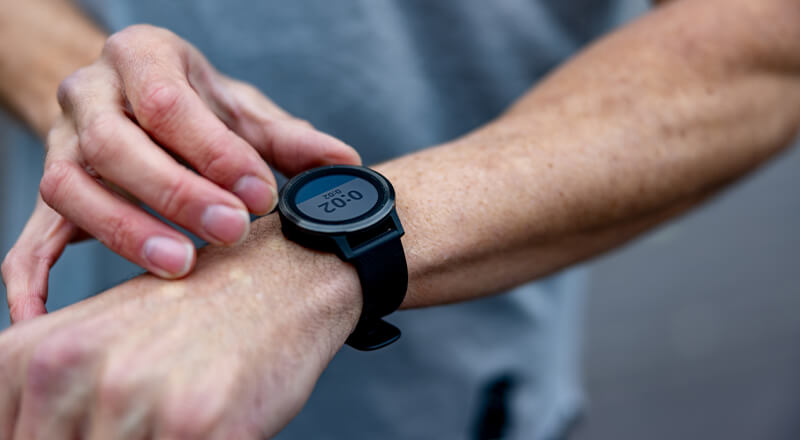Any running journey, whether it’s your first 5K or your 10th marathon, requires determination, training and a clear set of goals. We have expert advice on running from clinical experts to help you understand how to train, run and recover safely. Whether you’re just starting out or a seasoned runner looking to set new records, our training tips will help you achieve your running milestones and ensure you cross the finish line with pride.

The starting line
For new runners planning to lace up their running shoes and hit the pavement, it’s important to set realistic running objectives and ensure that you’re strong enough to support your ambitions. Benjamin Bring, DO, sports medicine physician at OhioHealth and medical director of the Cap City Half Marathon, suggests new runners spend time walking and building up mileage gradually.
“Too often we see injured runners who try to increase their speed and distance too quickly,” says Dr. Bring. “It’s crucial to ease into any new running program, whether it’s for a 5K or a marathon. Any major change in the amount of time or distance you spend running requires an acclimation period.”
Running programs and groups can be great resources for new and veteran runners training for a distance race. Training apps, such as a “couch to 5K program,” can provide a good framework for developing a running routine says Amy Harrison, athletic trainer and OhioHealth Athletic Performance Clinic coordinator. Because many programs take into consideration your current fitness levels and running experience, they can help you gradually increase your mileage to support your running goal.
“I tell my patients to start small, have a plan and stick to it,” says Amy. “No matter how much experience you have, your body needs time to adapt to any additional mileage, and the physical demands can be significant.”
There are many running health benefits. In addition to boosting your cardiovascular health, running also improves your bone density, balance and the quality of your sleep. It can also decrease your risk of developing cardiovascular disease and reduce anxiety and depression. However, both Dr. Bring and Harrison stress that if you have any existing health conditions or concerns, it’s important to check in with your medical provider before starting a new exercise program. This is especially true for people with chronic medical conditions such as high blood pressure, high cholesterol, diabetes, cardiovascular disease or if you’ve recently been injured or had surgery. For older runners, Dr. Bring says bone density can also be a concern, especially if you run on rough or uneven terrain, which can increase your risk for falls, fractures and stress injuries.

Get the fuel you need
Whether you’re planning to run a 5K or a marathon, Harrison explains that properly fueling up before a race can be a challenge. The trick lies in understanding how many calories you burn during your runs, how many calories you eat in a day and what you need to comfortably recover and prevent injuries.
Eating a balanced diet high in lean protein, healthy fats, fiber, fruits and vegetables, along with plenty of whole grains, can give your body the fuel it needs to train, race and recover. While many people avoid carbohydrates, Dr. Bring says they are great for runners because they can quickly boost your glycogen levels.
“I often tell my patients that you can’t out exercise a bad diet,” says Dr. Bring. “Avoiding processed foods, managing your portion sizes, avoiding sugary drinks and limiting alcohol will carve out space for the food your body needs.”
For runners considering longer distance races such as a half or full marathon, Dr. Bring says meeting with a registered dietitian can ensure you get the range of nutrients and calories you need to make it to the finish line.
Adequate hydration is also essential for runners of any distance. Many factors determine how much water you need to drink before, during and after a run or race. That includes the weather, how far you run, whether you run outdoors or inside and how much you sweat. Harrison also cautions against automatically reaching for a sports drink after a run unless you’ve been running for more than an hour.
“Most of us don’t need the added sugar,” she explains. “Plain old water is typically more than adequate to replace what we lose during a run and throughout the rest of the day.”
Monitoring your urine is the best way to gauge whether you are hitting or missing the hydration mark. Harrison says that your urine should be clear or light yellow. If it’s dark yellow or the color of apple juice, it’s time for a water break.

Going the distance
When working toward any new mileage goals, determining your optimal pace is crucial to help keep you running safely, finish strong and avoid burning out in the middle of a race. Harrison explains that developing a running pacing strategy can be challenge at first, but with some practice you’ll find what works best for you and your running style, as well as the length of time and distance you’ll be running.
The most common way to calculate your average running pace is to time your runs for a few days and then average out how long it takes you to run one mile. Dr. Bring says your target heart rate can also guide your speed. To determine your target heart rate, subtract your age from 220, and aim to keep your heart rate within 60-80% of that number.
Harrison explains no matter what your running pace is, the excitement of race day can throw any runner off course, which is why adequate training and preparation is so important.
“Most runners start faster than they should on race day because their adrenaline is pumping and this is what they’ve been working toward for weeks or even months,” she says. “I always recommend starting 30 seconds slower and then easing into your pace. You can always speed up halfway through the race if you need to, but it’s harder to keep going if you’ve depleted all your energy.”
Whenever you increase the time or distance you’re running, it’s likely you’ll experience a few changes to your body composition and overall health. While most of the changes you’ll notice are positive, such as a lower resting heart rate and how well your body uses oxygen, some changes are more frustrating. Harrison explains that runners often gain weight when they increase their mileage because their bodies are trying to hold on to the fuel it needs. She stressed this is normal and says your weight will even out with time. Another issue to anticipate is GI distress, which is the result of the bouncing and sloshing that happens in your gut while running. This too will go away with time and patience.
Sometimes, no matter how diligent you are about training and getting in your daily mileage, you just can’t bring yourself to go any further. Dr. Bring says that making sure your training is a good fit for you running goal can help prevent “hitting the wall,” which is a common issue for both new and veteran runners. By making sure you get in plenty of high-mileage runs before a full or half-marathon, you can help prepare yourself both mentally and physically before race day arrives. Harrison suggests you practice what you’ll do if you hit the wall during a race so that you can quickly reset. Whether it’s a short walking break, a few deep breaths or simply pushing through your run, it’s usually a case of mind over matter.

Strength and recovery
A cross-training program can benefit runners of any distance by strengthening the muscles that support and stabilize your body as you pound the pavement. Mixing strength training into your running routine a few days a week will help provide a strong foundation to help you maintain your running form and prevent muscle fatigue. Dr. Bring suggests focusing on exercises that improve hip stabilization and strengthen your core, glutes and lower back, such as lifting weights, yoga, Pilates and planks.
Harrison agrees that strong and flexible muscles are injury-resistant muscles. Strength training can improve your capillary density and glycogen stores, which impacts how efficiently you move. A strong core and back can also shave time off your runs and boost your mileage by reducing unnecessary movement.
Before a long run or race, it’s important to properly warm up for at least three to five minutes. Dr. Bring and Harrison recommend quick dynamic movements, exercises and stretches that activate your glutes such as bridges, high knees, toe walks or planks. Side-to-side lunges, butt-kickers, quad grabs and Frankenstein movements are also good options.
Any new fitness routine will inevitably come with aches and pains, and running is no exception. Dr. Bring says that widespread soreness or aching after a long run is normal and will dissipate with time, rest and gentle stretching. If you find that you are limping, or if you have bruising, swelling or pain at rest, it’s important to take some time off and contact your provider if the pain continues.
“Listening to your body is so important. If you need a break, take it and don’t push yourself,” says Harrison. “Knowing when to ease up can be really helpful when it comes to injury prevention.”
Training for a race of any length can be both a challenge and a tremendously rewarding experience. Steadily increasing your mileage will build your confidence as well as your stamina as you move closer to your race-day goals.
“When it comes to running any distance, starting low and slow is best,” says Dr. Bring. “With some time and commitment to your new routine you’ll be crossing that finish line with ease.”
Curious to learn more? Check out the OhioHealth’s Runner’s Clinic to up your running game.





